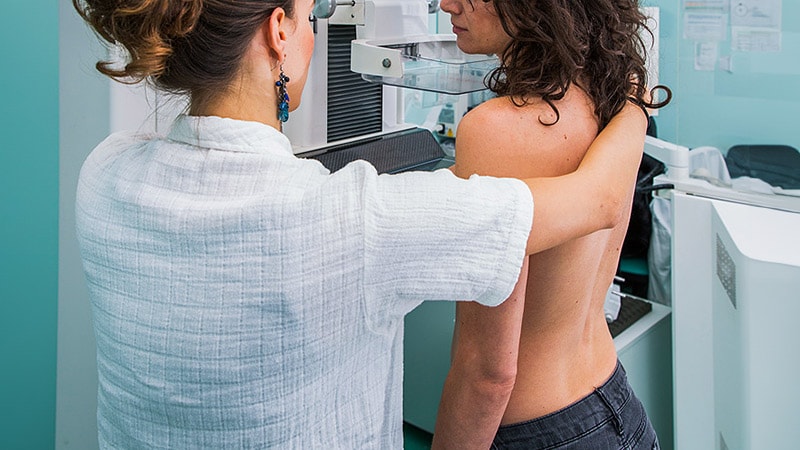US Preventive Services Task Force Recommends Routine Breast Cancer Screening Starting at Age 40 for Average-Risk Women
Core Concepts
The US Preventive Services Task Force (USPSTF) recommends that women at average risk for breast cancer should have mammograms every other year starting at age 40 until age 74, with a focus on addressing health disparities and gaps in evidence.
Abstract
The USPSTF has updated its breast cancer screening recommendations, advising that women at average risk should start routine mammograms every 2 years beginning at age 40, rather than the previous recommendation of starting at age 50. This change is based on a review of available data, including modeling from the Cancer Intervention and Surveillance Modeling Network (CISNET).
The updated recommendations highlight the need to address the fact that Black women are about 40% more likely to die from breast cancer than White women. The USPSTF also identified several evidence gaps, including the benefits and harms of continuing mammography after age 75, the use of digital breast tomosynthesis versus standard mammography, and the role of supplemental screening for women with dense breasts.
While the USPSTF recommends biennial screening, some experts argue that annual screening would be more effective in reducing breast cancer mortality. There is also a call for breast cancer risk assessments to begin at age 25 to identify high-risk women who should start annual MRI screenings.
The USPSTF's recommendations have generated some controversy, with editorials in JAMA discussing the balance between the benefits and harms of earlier and more frequent screening, as well as the need to address health inequities and the rapid advancements in screening technologies like artificial intelligence.
Routine Breast Cancer Screening Should Start at 40: USPSTF
Stats
Screening every 2 years starting at age 40 would avoid an additional 1.3 breast cancer deaths compared to screening starting at age 50.
For Black women, screening every 2 years starting at age 40 would avert an extra 1.8 breast cancer deaths per 1,000 people screened.
Screening every 2 years starting at age 40 would lead to a higher rate of false positive tests (8.5%) compared to starting at age 50 (7.8%).
Quotes
"Given mammography screening's modest benefits, we feel that all women—and particularly those aged 40 to 49 years—should be counseled about the benefits and harms of mammography and supported in deciding whether the balance of benefits to harms fits with their priorities and values."
"While AI algorithms show promise for enhancing cancer detection, their impact on patient outcomes and the balance between benefit and harms remain uncertain."
"Compared with no screening, annual screening would reduce rates of breast cancer mortality (35.2%) more than biennial (28.4%) screening does among women aged 40-74 years."
Key Insights Distilled From
by Kerry Dooley... at www.medscape.com 04-30-2024
https://www.medscape.com/viewarticle/routine-breast-cancer-screening-should-start-age-40-uspstf-2024a10008dz
Deeper Inquiries
How can the healthcare system better support women in making informed decisions about breast cancer screening based on their individual risk factors and preferences?
To better support women in making informed decisions about breast cancer screening, the healthcare system should prioritize personalized medicine approaches. This involves conducting thorough risk assessments that take into account individual factors such as family history, genetic predispositions, lifestyle choices, and personal preferences. Healthcare providers should engage in shared decision-making with patients, discussing the benefits and potential harms of screening at different ages, intervals, and modalities. Providing clear and unbiased information about the risks of false positives, overdiagnosis, and the potential benefits of early detection is crucial. Additionally, offering counseling and support services to help women navigate their options and make decisions aligned with their values and priorities can enhance the decision-making process.
What are the potential unintended consequences of adopting artificial intelligence tools for breast cancer screening too rapidly, and how can these be mitigated?
Rapid adoption of artificial intelligence (AI) tools for breast cancer screening may lead to unintended consequences such as algorithmic bias, increased rates of false positives or false negatives, and a lack of transparency in decision-making. Algorithmic bias can result in disparities in screening outcomes for certain demographic groups, potentially exacerbating existing health inequities. Moreover, overreliance on AI tools without proper validation and oversight can compromise patient safety and trust in the healthcare system. To mitigate these risks, it is essential to prioritize the development of AI algorithms that are transparent, interpretable, and regularly audited for bias. Healthcare providers should undergo training to understand the limitations and capabilities of AI tools, ensuring they are used as decision support rather than decision-making tools. Additionally, ongoing monitoring and evaluation of AI systems in real-world clinical settings can help identify and address any unintended consequences promptly.
Given the persistent evidence gaps identified by the USPSTF, what research priorities should be established to improve breast cancer screening guidelines and practices?
To address the persistent evidence gaps in breast cancer screening, research priorities should focus on several key areas. Firstly, studies should investigate the comparative effectiveness of digital breast tomosynthesis versus standard mammography for primary screening to determine the optimal imaging modality. Additionally, research is needed to evaluate the benefits and harms of continuing screening for women aged 75 years and older, as well as the effectiveness of supplemental screening modalities such as breast ultrasonography, digital breast tomosynthesis, or MRI in women with dense breasts. Furthermore, studies should aim to determine the proportion of ductal carcinoma in situ lesions detected by screening that would not have caused harm, helping to reduce overdiagnosis and overtreatment. Research on the best strategies for breast cancer screening in women with dense breasts, including the potential benefits of additional screening, is crucial to inform evidence-based guidelines and practices. Collaborative efforts between researchers, healthcare providers, and policymakers are essential to address these research priorities and improve breast cancer screening outcomes.
0
